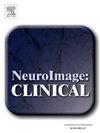特发性震颤患者随意运动时丘脑-皮质偶联的调节
IF 3.6
2区 医学
Q2 NEUROIMAGING
引用次数: 0
摘要
丘脑腹侧中间核(VIM)是小脑输入的主要丘脑中枢,也是特发性震颤(ET)的主要深部脑刺激靶点。因此,它可能在运动控制中起着关键作用。然而,这种结构很少在人类中进行研究,现有的研究主要集中在震颤上。在这里,我们研究了在自主运动过程中VIM的神经振荡及其与皮质振荡的耦合。我们研究了10例ET患者的丘脑-皮质耦合,结合丘脑局部场电位和脑磁图的记录。在录音过程中,患者根据视觉提示反复按下按钮。在全脑分析中,我们对比了运动前基线和按下按钮时的活动。按下按钮与双侧丘脑α (8-12 Hz)和β (13-21 Hz)功率下降和对侧γ (35-90 Hz)功率增加有关。α /低- β (8-20 Hz)相干性在运动过程中下降。这种作用局限于辅助运动区和运动前皮层。高β (21-35 Hz)相干性增加发生在同一区域,但比抑制更集中。运动前丘脑-皮层低相干性水平与反应时间相关。我们的研究结果表明,自主运动与行为相关的丘脑耦合调节有关,主要是运动前区域。我们观察到低频率和高频率之间的明显区别,我们的结果表明,起源于帕金森氏病研究的“反动力学”β振荡概念可转移到ET。本文章由计算机程序翻译,如有差异,请以英文原文为准。
Modulations of thalamo-cortical coupling during voluntary movement in patients with essential tremor
The ventral intermediate nucleus of the thalamus (VIM) is the main thalamic hub for cerebellar inputs and the primary deep brain stimulation target in essential tremor (ET). As such, it presumably plays a critical role in motor control. However, this structure is rarely studied in humans, and existing studies mostly focus on tremor. Here, we studied neural oscillations in the VIM and their coupling to cortical oscillations during voluntary movement.
We investigated thalamo-cortical coupling, combining recordings of thalamic local field potentials and magnetoencephalography, in 10 ET patients with externalized deep brain stimulation electrodes. During the recording, patients repeatedly pressed a button in response to a visual cue. In a whole-brain analysis of VIM-cortex coherence, we contrasted activity during pre-movement baseline and button pressing.
Button pressing was associated with a bilateral decrease of thalamic alpha (8–12 Hz) and beta (13–21 Hz) power and a contralateral gamma (35–90 Hz) power increase. Alpha/low-beta (8–20 Hz) coherence decreased during movement. This effect localized to the supplementary motor area and premotor cortex. A high-beta (21–35 Hz) coherence increase occurred in the same region but was more focal than the suppression. Pre-movement levels of thalamo-cortex low-beta coherence correlated with reaction time.
Our results demonstrate that voluntary movement is associated with modulations of behaviourally relevant thalamic coupling, primarily to premotor areas. We observed a clear distinction between low- and high-beta frequencies and our results suggest that the concept of “antikinetic” beta oscillations, originating from research on Parkinson’s disease, is transferable to ET.
求助全文
通过发布文献求助,成功后即可免费获取论文全文。
去求助
来源期刊

Neuroimage-Clinical
NEUROIMAGING-
CiteScore
7.50
自引率
4.80%
发文量
368
审稿时长
52 days
期刊介绍:
NeuroImage: Clinical, a journal of diseases, disorders and syndromes involving the Nervous System, provides a vehicle for communicating important advances in the study of abnormal structure-function relationships of the human nervous system based on imaging.
The focus of NeuroImage: Clinical is on defining changes to the brain associated with primary neurologic and psychiatric diseases and disorders of the nervous system as well as behavioral syndromes and developmental conditions. The main criterion for judging papers is the extent of scientific advancement in the understanding of the pathophysiologic mechanisms of diseases and disorders, in identification of functional models that link clinical signs and symptoms with brain function and in the creation of image based tools applicable to a broad range of clinical needs including diagnosis, monitoring and tracking of illness, predicting therapeutic response and development of new treatments. Papers dealing with structure and function in animal models will also be considered if they reveal mechanisms that can be readily translated to human conditions.
 求助内容:
求助内容: 应助结果提醒方式:
应助结果提醒方式:


